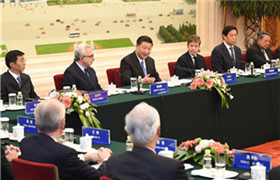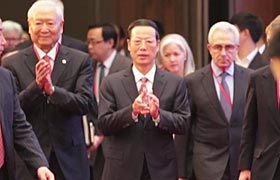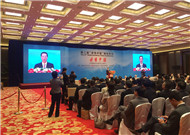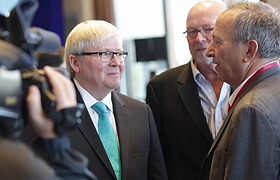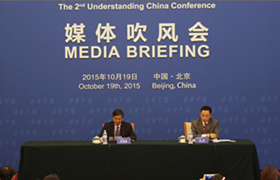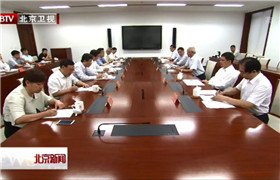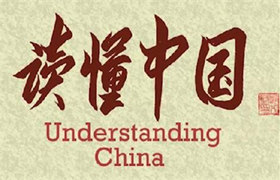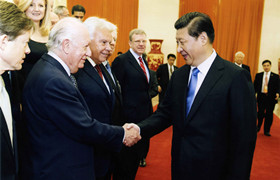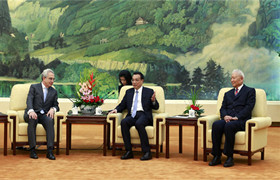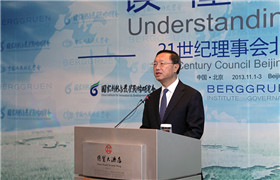- HOME--> Thought
-
Reinvigorating the gan kao spirit is a best way of celebrating the 95th birthday of the CPC
Source:
Gan Kao and the Communist Party of China
--In commemoration of the 95th anniversary of the founding of CPC
Zheng Bijian
Reinvigorating the gan kao spirit is a best way of celebrating the 95th birthday of the CPC
Ninety-five years ago today the Communist Party of China was founded. We are celebrating this monumental moment of its 95th birthday! As we review the arduous journey the party has traversed over those years and examine the historic challenges it is faced with at present, we reach the conclusion that its entire history is one of taking one big test after another (or gan kao, which literally means high imperial exam).
As many of us know, it was Mao Zedong who had first used the word gan kao as a metaphor to describe the challenges the CPC was meeting with. It was on March 23, 1949, on the eve of the founding of New China, when Mao Zedong and the CPC Central Committee departed their “last rural base” in Xibaipo and headed into Beijing (known as Peking then). Contrasting the CPC with Li Zicheng (1606-1645), who indulged in extravagant and dissolute lifestyles after taking Beijing, he exhorted the party, “Under no circumstances can we be anything like Li Zicheng. We are going to Beijing for gan kao. All of us have to make the grade.” Those words of admonition inspired the use of gan kao as a catchword by CPC members ever since then to refer to the party’s tackling of severe challenges.
Shortly after the conclusion of the 18th National Congress of the CPC, Xi Jinping, the newly elected General Secretary of the CPC Central Committee made an inspection tour to Xibaipo. “When Comrade Mao and the CPC Central Committee were leaving Xibaipo for Beijing, he said they were doing so for gan kao there,” he remarked during a meeting with local party cadres and residents. “We have made tremendous progress over the past 60 years and more. The Chinese people have stood up and are living better lives. Nevertheless, the challenges and problems in front of us remain complex and daunting. This means that the party’s gan kao is far from over.” How sober and yet earnest and inspirational these words are!
As we review the 95-year history of the CPC, those words of Chairman Mao and President Xi point to the truth that the party has been continuously taking big tests. Passing one test with honors is no guarantee that we will pass the future ones. In other words, gan kao never ceases.
Reviewing the history of gan kao of the CPC and reinvigorating the spirit of gan kao, which defines the party as being modest, prudent, hard-working, and undeterred by difficulties, are a best way of celebrating its 95th birthday.
Soon after its birth, the CPC embarked on the road of gan kao throughout the great revolution of the people. These gan kao resulted in a unique strategy of encircling cities from rural areas, Mao Zedong Thought which integrated Marxism with Chinese realities, and the founding of Socialist New China with the people being its masters.
After the Opium War in 1840, China was relegated to semi-colonial and semi-feudal status. Bullied and humiliated by imperialist powers, the whole nation was plunged into abysmal misery, with widespread social unrest. Feudalism no longer worked, and the constitutional monarchy, multi-party system, and parliamentary democracy from the Western world were tried and failed. The Chinese revolution broke new ground only when a group of advanced intellectuals embraced Marxism and the Communist Party of China came into being. The CPC itself was a result of continuous gan kao by the Chinese people.
Thereafter, the CPC experienced a series of major gan kao to rejuvenate the Chinese nation, turning the tide in critical situations and overcoming all obstacles in its way.
Through the first major gan kao of the CPC, which comprised the Northern Expedition (1926-1927) and the Agrarian Revolutionary War (1927-1937), the CPC blazed a unique path for the Chinese revolution, which is encircling the cities from rural areas. Fighting imperialism and feudalism constituted the program of democratic revolution adopted at the Second National Congress of the CPC. However, how would this work, especially amid the “White Terror” masterminded by Chiang Kai-shek? Should the party remain in cities or move down to the countryside? Not many inside the party had a clear-cut stance on the issue, and even some of the officers of the Red Army already stationed in the countryside wavered, saying, “How long can the red flag last?” Based on an incisive analysis of the current domestic and international situations, Mao Zedong pointed out, “The long-term survival of one or more small areas under Red political power completely encircled by a White regime is a phenomenon that has never occurred anywhere else in the world.” In those days China was “semi-colonial and was under indirect imperialist rule”, and the ruling classes engaged in “prolonged and tangled warfare”. Based on a clear, sober appraisal of Chinese realities and the international situation, these profound statements were truly manifestations of Marxism with Chinese characteristics and marked the formation of the strategy for the Chinese revolution, which is encircling cities from the rural areas.
The second major gan kao of the CPC occurred during the War of Resistance Against Japan (1937-1945) and consisted of resisting the prolonged suppression of the Communists by the KMT while upholding the United National Front Against Japanese Aggression. The CPC won the first complete victory in resisting foreign aggressors in modern Chinese history. Soon after the Red Army forces reached Northern Shaanxi, a number of questions confronted the CPC. At a time when the national contradiction between China and Japan was prevailing, should they seek a second CPC-KMT cooperation while the latter was conceiving more bloodshed? Should they maintain independence in the United National Front Against Japanese Aggression? After the outbreak of the Wannan Incident of 1941 (also known as New Fourth Army Incident), should they fight against Chiang Kai-shek? If so, what about the War of Resistance Against Japan? Ultimately the party put forward a dual strategy that synthesized “alliance” and “struggle” as the answer to this array of most difficult questions. It was neither “all struggle and no alliance” nor “all alliance and no struggle”; rather, it was a strategy of “uniting with all social strata opposed to Japanese imperialism, of forming a united front with and yet of waging struggles against them, struggles that differ in form according to the different degrees in which their vacillating or reactionary side manifests itself in capitulation to the enemy and opposition to the Communist Party and the people.” The dual nature of the strategy also manifested itself in the labor and land policies adopted. It consolidated and further developed the United National Front Against Japanese Aggression, which laid the broadest mass foundation for winning the War of Resistance Against Japan. Conceived and formalized in the war years, the strategy is now a most valuable asset of the CPC.
The third major gan kao of the CPC was that of carrying out the War of Liberation (1945-1949) amid all difficulties and challenges and thus putting an end to the revolution. After the War of Resistance Against Japan was concluded, Chiang Kai-shek, in gross defiance of the wishes of the Chinese people, smashed the peace agreement reached at the Chongqing Negotiations. The CPC was put in a critical situation. On the one hand, the imperialist powers led by the United States were supportive of Chiang Kai-shek launching a full-blown civil war.
On the other hand, the Soviet Union coerced the CPC into compromising to Chiang Kai-shek because its relations with the United States, the United Kingdom, and France ameliorated. The party had to choose between compromising to Chiang Kai-shek and carrying the revolution to the end. At the critical moment Mao Zedong made the historical statement, “Such compromise (between the United States and the Soviet Union) … does not require the people in the countries of the capitalist world to follow suit and make compromises at home. The people in those countries will continue to wage different struggles in accordance with their different conditions.” Hence, based on a systematic analysis of the domestic and international situations, the party made the historic decision of carrying the revolution to the end by toppling the reactionary rule of the KMT and ultimately founding New China with the people as its masters.
The fourth major gan kao of the CPC occurred after the victory of the New Democratic Revolution (1919-1949) and was that of transforming China from a semi-colonial and semi-feudal agrarian country into an advanced industrialized country. The party made the strategic decision of combining the transformation with the change from New Democracy to Socialism. The general line for the transitional period included the following: concentrating on the construction of large and medium-sized industrial projects as the primary foundation for industrialization; and supporting industrialization by transforming agriculture and handicraft industries on the one hand and private industry and commerce on the other. By 1956 the party had established the basic socialist system in China, as a big country in the East, an achievement that was unprecedented in the history of human events.
In summary, China experienced the New Democratic Revolution and Socialist Revolution over the span of 35 years from 1921 to 1949 and then to 1956. As aforementioned, the CPC had four major gan kao during this period, each occurring in a critical moment in her history. What did these gan kao accomplish? These are summarized as follows: the decisively distinctive revolutionary path of encircling cities from the rural areas; Mao Zedong Thought both as an achievement of the first collective central leadership of the CPC with Mao Zedong at the core and as the result of the first historic transformation of Marxism in China; and the establishment of socialist New China with the people as its masters. In other words, the CPC emerged from these gan kao as the vanguard of both the Chinese working class and the Chinese people and nation.
Since the initiation of reform and opening up, the CPC has been on the road of new gan kao for the overriding mission of “catching up with the times”. These have led to a truly vibrant China, the theory of building socialism with Chinese characteristics as a result of the second historic transformation of Marxism within China, and ultimately China as the world’s second largest economy.
The Third Plenary Session of the 11th Central Committee of the CPC convened in 1978 ushered in a new era in Chinese history, that is an era of reform and opening up. Henceforth, the CPC set forth on a new gan kao with the mission of “catching up with the times”.
The party has been on the road of new gan kao for 34 years, from the establishment of socialism with Chinese characteristics under the helm of Deng Xiaoping to the new phase of socialist modernization and to the convening of the 18th National Congress of the CPC. It has gone a long way during this period of time.
The first major gan kao of the CPC was that of putting the Cultural Revolution to an end and bringing emancipation of the mind on track. The Cultural Revolution caused prolonged, systemic turmoil, with catastrophic consequences for the economy and ideology. Reversing social stagnation and ridding the people of ossified ideology, including “taking class struggle as the key link” and the “Two-whatever” doctrine proved to be an uphill battle for the party. It was under Deng Xiaoping that the floodgate of emancipation of the mind was resolutely released, with the focus on understanding what socialism was and how socialism should be built. Ultimately, the nation embarked on the path of building socialism with Chinese characteristics—a path of liberating productive forces and restoring and strengthening social vitality. Thus, from the great national debate on the criterion for truth to the 3rd Plenary Session of the 11th Central Committee of the CPC, China came out of stagnation and headed toward true dynamism, releasing the great potentials and vitality of the people and society. This represents the most profound change in the history of modern China.
The second major gan kao of the CPC was that of addressing the political disturbances at home and abroad. By wringing order out of chaos and implementing reform in an all-round manner in the wake of the Cultural Revolution, the party adopted the right policies and brought the nation on a correct path of development. The people were adequately fed and clothed by and large. However, many social contradictions accumulated and came to the fore in the process. These and the complex international situation combined to trigger the political turmoil in 1989. With the collapse of the Soviet Union and the dramatic changes in East European countries, the party had to answer the more imperative question, “How long will the socialist red flag last?” At the critical juncture, Deng Xiaoping, aged 88 then, paid an inspection tour to the South, on which he made remarks (widely known as the Southern Tour Talks) calling for rectifying ideological chaos and setting the nation firmly in the directions of reform and development. Shortly afterwards the third volume of Selected Works of Deng Xiaoping was published, stirring a fervor of studying Deng Xiaoping Theory within the party. It was not long before reform and opening up made historic breakthroughs and a socialist market economic system took initial shape. China was on the way to becoming a moderately well-off society.
The third major gan kao of the CPC was that of withstanding the adverse effects of the Asian financial crisis and gaining accession to the World Trade Organization. The financial crisis put the Chinese economy to a severe test. Thanks to the resolute, correct decisions made by the central leadership, China survived the crisis while the Four Asian Tigers were hard hit. Then, the central leadership made another correct decision of joining the World Trade Organization. Joining the WTO and hence participating in economic globalization was to maximize China’s achievement. Practice has shown that China has been a beneficiary rather than victim of economic globalization. In the next decade, which was devoted to building China into a moderately well-off society in an all-round manner, GDP registered double digit annual growth rate and the country became the second largest economy in the world. The global financial crisis of 2008 put China to yet another severe test, and again the country survived it. Since then, the party has made conscientious efforts to promote scientific, harmonious, and peaceful development.
As Deng Xiaoping had emphasized, reform serves the goal of “catching up with the times”. With this as its mission, the CPC forged ahead on the road of gan kao over the 34- year period from the 3rd Plenary Session of the 11th Central Committee until the eve of the convening of the 18th National Congress of the CPC. China became a vibrant society. The theories of building socialism with Chinese characteristics was established as the results of the second historic transformation of Marxism in China spearheaded by Deng Xiaoping and collectively promoted by the party represented by President Jiang Zemin and President Hu Jintao. These included Deng Xiaoping Theory, the Three Represents, and the Scientific Outlook on Development. China leapt to be the second largest economy in the world.
The CPC has been on a new journey of gan kao since the opening of the 18th National Congress of the CPC.
It was explicitly stated at the 18th National Congress of the CPC that the party has the following dual tasks: building China into a moderately well-off society in an a comprehensive manner at the time the party is 100 year old; and building China into a modern socialist country that is prosperous, democratic, civilized, and harmonious at the 100th anniversary of the founding of China. We are blessed with the opportunities for accomplishing the tasks, and the people place higher and higher expectation on us. At the same time, however, we are presented with a number of challenges on the road of building socialism with Chinese characteristics. The international situation is complex and severe. The economy faces large downward pressure, and the reforms, especially the supply side reform, are unprecedentedly tough. On the ideological and cultural fronts, pluralist tendencies facilitated by the Internet are growing and unprecedented. Also, it is imperative that strict party disciplines be enforced. Upon reflection, we cannot but be convinced that President Xi Jinping’s remark during his tour to Xibaipo that our gan kao is far from over is of far-reaching importance.
In preparing for the new journey of gan kao amid numerous difficulties and obstacles, the Central Committee of the CPC led by President Xi Jinping has mapped out a series of new plans of action and roadmaps for governance and party building. Over the past three years, upholding the principle that “strict party disciplines are essential for governing the country well”, the Central Committee has enforced strict party disciplines in a comprehensive manner, combining education and disciplinary action, from the Political Bureau of the CPC all the way downward. It has also laid out the dual plans of action of “comprehensively deepening reform” and “governing the country by law in a comprehensive manner”, thus completing the Four Comprehensives strategy. It has formulated the 13th Five-year Plan guided by the principles of innovation, coordination, greenness, openness, and sharing. In one word, we have had a good beginning, with great future ahead albeit the many difficulties.
According to my understanding, each of the “Four Comprehensives” is associated with a dual mission.
Under the guideline of “building China into a modestly well-off society in a comprehensive manner”, we cannot but face the “dual mission” of continuing to complete traditional industrialization, which has long been achieved by developed countries, and promoting new-type industrialization, information industries, agricultural modernization, and urbanization in this era of a new and great revolution of modern science and technology. Steel and machinery production alone does not mean industrialization although it had underpinned much of the Industrial Revolution in history. The path of relying on massive investments at the cost of the environment or adopting technologies without any regard of the impact on employment has proven to be unsustainable and is not to be replicated. In our way forward in building a modern, affluent society for the Chinese people of 1.3 billion and more, we need to concentrate on green development as the new goal, with innovation being the primary driver for growth and information technologies being the facilitating force.
Under the guideline of “deepening reform in a comprehensive manner”, we cannot but face the “dual mission” of releasing and developing productive forces through reforms oriented toward a socialist market economy on the one hand and promoting social justice and common prosperity on the other. In essence, developing a socialist market economy for social vitality and efficiency is compatible with advancing social justice and common prosperity. At certain times these two goals may contradict each other on a number of issues; in the long run, however, they mutually support and reinforce each other. In addressing these contradictions, we need to plan well, with all factors taken into consideration, and proceed from a long-term perspective, without expecting to win it all in one battle.
Under the guideline of “governing the country by law in a comprehensive manner”, we cannot but face the “dual mission” of comprehensively strengthening leadership by the CPC on the one hand and making sure the CPC conduct all activities within the confines of the Constitution and laws on the other. It is under the leadership of the party that the Constitution and laws are formulated and implemented. So the party must take the lead in conducting all activities within the confines of the Constitution and laws. In doing so, we serve as exemplars and better exercise our leadership roles. Leadership by the party and governance by law are highly consistent with each other. Handling their relationship well is crucial for governance by law and for wellbeing of the party and the nation; otherwise, governance by law will be weakened and the party and the nation will be in jeopardy.
Under the guideline of “strictly governing the party in a comprehensive manner”, we cannot but face the “dual mission” of enforcing party disciplines strictly on the one hand and strengthening party cadres’ ideological convictions and inspiring them to be responsible and competent in their leadership roles, on the other. The former is necessary because some party cadres are irresponsible or undisciplined in doing things or even engage in lawless activities, and the latter is necessary because some party cadres are idle or ineffectual in their leadership roles. Strict disciplines are designed not only to address inactivity and corruption among the cadres within the party who are “small in number but play critical roles” but also to have them inspired and motivated as they discharge their official duties. Effective governance of the party amid the challenges at present is crucial for the success of its lofty cause.
On the international front, as with the domestic situation, we cannot but face the “dual mission” of unswervingly following the path of peaceful development on the one hand and upholding national sovereignty and security (including the building of powerful national defense) on the other. We pursue the path of peaceful rise which is unprecedented and distinguished from the paths of emerging powers in modern world history. Peace and development are still the dominant themes of the present world. However, the Cold War mentality, hegemony, and power politics persist in certain big powers. New-type relations and traditional relations among big nations co-exist, and while the former are newly emerging, the latter are intertwined. There are three approaches to these relations, which may be described as follows: cling to the Cold War mentality and engage in all sorts of cold war; engage in regional warfare without launching a world war; or blaze a new path by managing conflicts and fostering a non-exclusive “circle of friends” and by constructing international and regional communities based on common interest and fates. We stand for the third approach while we are opposed to and not deterred by the first two.
In one word, our journey of gan kao in the new historic era will be smooth and promising if we are determined to fight a long-drawn-out, tenacious battle. This means maintaining the integrity of the policies of the Central Committee and ensuring that they are carried out strictly and truthfully.
The CPC emerged from gan kao in numerous critical moments in its history to become the vanguard of both the Chinese working class and the Chinese people and nation. The party is now amidst gan kao of catching up with the times in a “new age of the masses.”
Going through untold trials and tribulations, hard struggles, and sacrifices over the past 95 years of gan kao, the CPC has evolved from a small party of around 50 members in 1921 to a major party of more than 88 million at present. We are firmly convinced that we will ultimately fulfill our lofty ideal of communism and national rejuvenation. Under the party’s leadership, the Chinese people have independently engaged in revolution, development, and reform. At present and for a fairly long period of time to come, we will be devoted to building socialism with Chinese characteristics. The CPC is rightfully the vanguard of both the Chinese working class and the Chinese people and nation. There is no other party like it in the entire world!
The practice of the 95-year gan kao of the CPC is eloquent proof that gan kao is all about testing the party’s own strength and capabilities. The party has, over the past 95 years, attached utmost importance to self-construction by continuously improving itself in the process of taking bold steps to redress mistakes as they are committed and we will continue to do so in the future. That’s the fundamental reason why it has survived all kinds of severe tests and keeps rejuvenating itself.
Let’s go over how the CPC has kept strengthening itself during the past 95 years. It has consistently done so through a series of landmark events, decisions and resolutions. These included the Gutian Congress (1929), the Yan’an Rectification Movement (1941-1945), the first resolution on historical issues concerning the party (1945), the Debate on the Criterion of Truth (1978), and the second resolution on historical issues concerning the party (1981). Over the past several decades, there have been the “Three-emphasis” education, campaign to maintain the advanced nature of CPC members, practicing the scientific outlook on development, the “mass-line” campaign, and the ongoing education initiatives of “Three Stricts and Three Earnests” and “Two Studies, One Action.” That’s why the CPC has been and will continue to be the leader, backbone and guide on the road to renaissance of the Chinese nation.
The party redresses mistakes as they arise. Also, it is oriented toward the future, with a clear-headed understanding and appraisal of the times. In essence, gan kao is aimed at catching up with the times. At each historic juncture over the past 95 years, earthshaking changes taking place both internationally and domestically brought the CPC on the road of gan kao, leading to a transformation of Marxism. This transformation, in turn, continuously stimulated and guided historic changes for China to catch up with the times and, at the same time, to be ahead of and lead the times.
There are two dimensions to the concept of catching up with the times. With regard to the international front, following the earlier discussion, I would like to emphasize that we need to carefully analyze and firmly grasp the distinguishing characteristics and trends in all areas of endeavor in today’s world, based on a clear-headed understanding of the dominant themes and international relations of the times. These encompass the following, among others: leaps and bounds in productivity growth; breakthrough advances in science and technology, education, and culture; rivalry among social, political, economic, cultural, and national defense systems; coexistence of wide-ranging international cooperation and intense competition; and threats to peaceful development (including cold war tendencies and regional conflicts and warfare). We must keep alert and trust that we will be better able to comprehend and grasp these characteristics and trends as they unfold and evolve over time.
On the domestic front, the situation is complex and complicated and requires greater attention. I would like to emphasize that we are living in a new historic era of the masses. Chairman Mao pointed out at the 7th National Congress of the CPC (1945) that the people are our “God”. At the Yan’an Forum on Literature and Art (1942), he elaborated on the importance of “being one with the new masses” and “integrating into the new epoch of the masses”. As we celebrate the 95th anniversary of the founding of CPC, we are aware of the monumental changes the country and society are undergoing. Among the most notable of these is that we are living in a new era of the masses in the 21st century. These “new masses” are a great workforce active in all spheres of endeavor, including science and technology, education, culture, national defense, entrepreneurial industries, and so on, and are a new force expanding the ranks of party members and cadres. They are energetic, enterprising, and more self-aware. Undoubtedly, they will be the leading force for achieving the “Two Centenary Goals” and the China Dream of the great renaissance of the Chinese nation. Hence, they are our future. This requires that the party make genuine efforts to learn how to be one with and rely on them. This is nothing less than a critical gan kao! Accordingly, our distinguished “mass-line”, which had brought us hand in hand with millions upon millions of masses in our history, needs to play a more prominent role and be further expanded.
The 18th National Congress of the CPC calls upon us “to be prepared for a great struggle with a number of distinguished historic characteristics”. The “great struggle” of the new era is right in front of us! With that the new gan kao is upon us! At this historic moment, we need all the more to strengthen our political awareness, awareness of the overall situation, awareness of the party leadership with President Xi Jinping at the core, and the awareness of allying ourselves with the party. Under the leadership of the Central Committee of the CPC led by President Xi Jinping, we are united in one heart and are making concerted efforts to achieve the China Dream of the great renaissance of the Chinese nation.
In the final analysis, reviewing the history of gan kao of the CPC and reinvigorating the spirit of gan kao, which defines the party as being prudent, hard-working, and undeterred by difficulties, are a best way of celebrating its 95th birthday!
The author, Mr. Zheng Bijian is Executive Vice-President of the Party School of the CPC Central Committee and Director of the Academic Affairs Committee of the Party School of the CPC Central Committee.
The article was published in the July 1, 2016 issue of The People’s Daily.
-
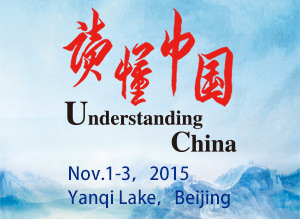
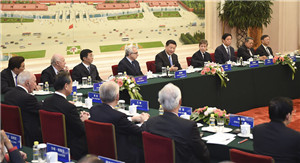
The 2nd "Understanding China" ConferenceOn November 1~3, 2015, the 2nd “Understanding China” Conference was held in Beijing Yanqi Lake International Conference Center. Zhang Gaoli, Vice Premier of the State Council, attended the opening ceremony.
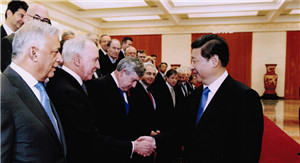
The 1st "Understanding China" ConferenceOn November 1~3, 2013, the 1st “Understanding China” Conference was held in Beijing, which was cosponsored by China Institute for Innovation & Development Strategy (CIIDS), Chinese People’s Institute of Foreign Affairs (CPIFA), and Berggruen Institute on Governance.
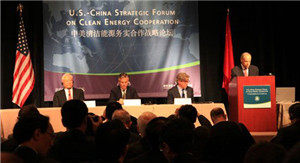
The 2nd U.S.-China Strategic Forum on Clean Energy CooperationWith the “Prospects for U.S.-China strategic cooperation in next decade” as its theme, the forum dwells on the implications of U.S.-China cooperation from the strategic perspective of coping with global challenges and maintaining world peace.
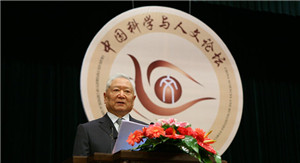
The China Sciences and Humanities ForumCo-initiated in April 2003 by renowned Chinese scientist Mr. Lu Yongxiang and influential political strategist Zhen Bijian, China Sciences and Humanities Forum was jointly hosted by Graduate University of Chinese Academy of Sciences (GUCAS) and the Higher Education Press.


